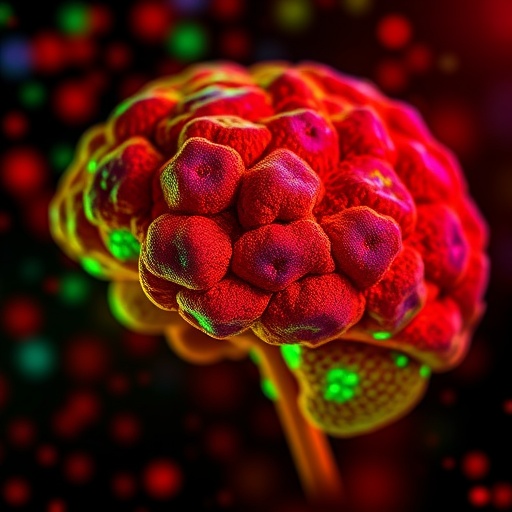In a groundbreaking new study, researchers have unveiled the intricate molecular interplay that governs microglial phagocytosis within the context of Alzheimer’s disease, focusing particularly on the role of RNA modifications. The research, conducted using the well-established APP/PS1 mouse model, sheds light on how the epitranscriptomic mark N6-methyladenosine (m6A) steers immune responses in the brain’s resident macrophages, the microglia, which are crucial players in maintaining neural homeostasis and combating protein aggregation.
Alzheimer’s disease, a neurodegenerative disorder hallmarked by cognitive decline and memory loss, is notoriously complicated due to the convergence of genetic, environmental, and cellular factors. One key hallmark of Alzheimer’s pathology is the accumulation of amyloid-beta plaques, against which microglia deploy their phagocytic machinery in an attempt to clear these toxic aggregates. However, the functional regulation of microglial phagocytosis has remained elusive, particularly how post-transcriptional modifications fine-tune these immune cells within a diseased milieu.
The study centers on N6-methyladenosine, the most abundant internal modification found in eukaryotic mRNA, which has recently emerged as a vital regulator of RNA metabolism affecting mRNA splicing, stability, export, and translation. Notably, m6A modifications orchestrate multiple aspects of cell fate decisions and immune cell functions, but their role in neurodegeneration-linked microglial behavior has not been fully delineated until now.
.adsslot_bsLYA70o3v{width:728px !important;height:90px !important;}
@media(max-width:1199px){ .adsslot_bsLYA70o3v{width:468px !important;height:60px !important;}
}
@media(max-width:767px){ .adsslot_bsLYA70o3v{width:320px !important;height:50px !important;}
}
ADVERTISEMENT
Utilizing the APP/PS1 mouse model, which carries both amyloid precursor protein and presenilin-1 mutations, the investigators performed comprehensive molecular and cellular analyses to interrogate the influence of m6A RNA modifications on microglial phagocytic activity. Through a combination of immunohistochemistry, transcriptomic profiling, and m6A mapping techniques, the research revealed that the differential methylation patterns of specific transcripts critically modulate microglia’s ability to engulf and clear amyloid-beta.
Central to this process are m6A “writer” enzymes, such as METTL3, which deposit methyl marks on mRNA, and “reader” proteins that interpret these marks to influence downstream gene expression. The researchers found that altering the expression of METTL3 in microglia led to substantial changes in the efficiency of phagocytosis and inflammatory responses, suggesting that m6A modifications are not merely passive marks but active regulators of microglial function in Alzheimer’s disease.
Complementary to these findings, the study highlights how changes in m6A methylation influence signaling pathways critical for cytoskeletal rearrangement, receptor-mediated engulfment, and lysosomal degradation. These pathways collectively determine the capacity of microglia to recognize, internalize, and process amyloid-beta peptides. By mapping m6A sites on transcripts encoding phagocytosis-related proteins, the authors uncovered robust links between epitranscriptomic regulation and immune clearance mechanisms.
Moreover, this study bridges multiple fields, converging RNA biology, immunology, and neuroscience, thereby adding a vital piece to the puzzle of Alzheimer’s pathology. The precise temporal and spatial regulation of m6A modifications could explain why microglia adopt dysfunctional phenotypes in the diseased brain, often contributing to chronic inflammation and neuronal damage rather than neuroprotection.
Importantly, the researchers employed cutting-edge techniques such as m6A individual-nucleotide-resolution crosslinking and immunoprecipitation (miCLIP) to generate high-resolution maps of m6A sites in microglial transcriptomes. This allowed them to associate specific methylation changes with functional shifts in microglial behavior with unprecedented clarity. Such technical advances underscore the growing importance of epitranscriptomics in understanding complex diseases beyond cancer and developmental biology, extending profoundly into neurodegenerative disorders.
The APP/PS1 model, widely utilized in Alzheimer’s research, faithfully recapitulates amyloid pathology, making it a valuable platform to examine how modulating RNA modifications influences disease progression. The study’s multidimensional approach—integrating molecular biology, imaging, and behavioral assays—offers convincing evidence linking epitranscriptomic regulation with the dynamic cellular processes underlying Alzheimer’s disease.
Additionally, the study explores how m6A-mediated regulation intersects with other key pathways implicated in Alzheimer’s disease, including neuroinflammatory signaling cascades. By tweaking the m6A landscape, microglia shift between pro-inflammatory and homeostatic states, which has profound implications for disease severity and progression. This dual role positions m6A RNA modification as a master regulator of microglial plasticity – an essential feature for effective defense and repair in the brain.
From a broader perspective, these findings compel a re-examination of therapeutic targets in neurodegeneration, moving beyond protein-centric approaches to encompass RNA modifications that dictate gene expression profiles. The nuanced control over microglial activity by m6A blurs the lines between genetic predisposition and environmental modulation, thus enriching our grasp of Alzheimer’s disease etiology.
Future research inspired by these insights may involve pharmacological agents that selectively modulate m6A “writers,” “erasers,” or “readers” in microglia, fine-tuning immune responses without broadly suppressing microglial function. Such precision medicine strategies could revolutionize treatment paradigms by harnessing the innate capacity of brain immune cells to clear pathological aggregates effectively.
The broader implications of this study extend to other neurodegenerative diseases marked by dysfunctional glial responses, such as Parkinson’s disease and multiple sclerosis. Understanding how m6A RNA methylation governs phagocytosis and inflammation in microglia could provide a unifying epigenetic mechanism underlying diverse neurodegenerative pathologies, opening new avenues for multi-disease therapeutic design.
Notably, this research encourages the field to integrate epitranscriptomic profiling as a standard analytic layer in neurodegenerative investigations, paralleling genomic and proteomic workflows. Doing so may unveil previously unrecognized regulatory networks and biomarkers, enabling earlier diagnosis and targeted interventions informed by RNA modification status.
In conclusion, the compelling evidence presented highlights the pivotal role of N6-methyladenosine RNA modification as a critical regulator of microglial phagocytosis within the Alzheimer’s disease brain. By delineating this novel epitranscriptomic axis, the study not only expands fundamental understanding of microglial biology but also heralds innovative therapeutic opportunities that could transform the landscape of neurodegenerative disease treatment.
Subject of Research: The regulation of microglial phagocytosis by N6-methyladenosine (m6A) RNA modification in the context of Alzheimer’s disease.
Article Title: N6-methyladenosine RNA modification regulates microglial phagocytosis in the APP/PS1 mouse model of Alzheimer’s disease.
Article References:
Qu, X., Lin, L., Li, Y. et al. N6-methyladenosine RNA modification regulates microglial phagocytosis in the APP/PS1 mouse model of Alzheimer’s disease. Genes Immun (2025). https://doi.org/10.1038/s41435-025-00347-1
Image Credits: AI Generated
DOI: https://doi.org/10.1038/s41435-025-00347-1
Tags: Alzheimer’s disease pathologyamyloid-beta plaque clearanceAPP/PS1 mouse modelepitranscriptomic regulationimmune responses in the brainm6A RNA modificationmicroglial immune cell functionsmicroglial phagocytosis in Alzheimer’sneurodegenerative disordersneuroinflammation and cognitive declinepost-transcriptional modifications in neurodegenerationRNA metabolism and microglia





